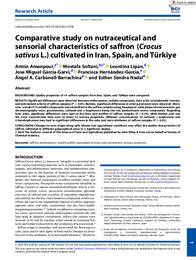Por favor, use este identificador para citar o enlazar este ítem:
https://hdl.handle.net/11000/32390Registro completo de metadatos
| Campo DC | Valor | Lengua/Idioma |
|---|---|---|
| dc.contributor.author | Hernández, Francisca | - |
| dc.contributor.author | Amanpour, Armin | - |
| dc.contributor.author | Soltani, Mostafa | - |
| dc.contributor.author | Lipan, Leontina | - |
| dc.contributor.author | GARCÍA GARVÍ, JOSE MIGUEL | - |
| dc.contributor.author | Carbonell-Barrachina, Ángel A. | - |
| dc.contributor.author | Sendra Nadal, Esther | - |
| dc.contributor.other | Departamentos de la UMH::Producción Vegetal y Microbiología | es_ES |
| dc.date.accessioned | 2024-07-01T10:08:35Z | - |
| dc.date.available | 2024-07-01T10:08:35Z | - |
| dc.date.created | 2024-01 | - |
| dc.identifier.citation | Journal of The Science of Food and Agriculture; 2024 | es_ES |
| dc.identifier.issn | 0022-5142 | - |
| dc.identifier.issn | 1097-0010 | - |
| dc.identifier.uri | https://hdl.handle.net/11000/32390 | - |
| dc.description.abstract | BACKGROUND: Quality properties of 14 saffron samples from Iran, Spain, and Türkiye were compared.RESULTS: Significant differences were observed between anthocyanins, volatile compounds, fatty acids, total phenolic content,and antioxidant activity of saffron samples (P < 0.05). Besides, significant differences in color parameters were observed. More-over, a total of 13 volatile compounds were identified in the saffron samples using. headspace–solid-phase microextraction–gaschromatography–mass spectrometry, safranal and ⊍-isophorone being the two predominant aroma compounds. Regardingfatty acids, significant differences were seen in the fatty acid profiles of saffron samples (P < 0.05), while linoleic acid wasthe most concentrated fatty acid. In terms of sensory properties, different concentrations of safranal, ⊍-isophorone and4-ketoisophorone may lead to significant differences in the odor and taste attributes of saffron samples (P < 0.05).CONCLUSION: Changes in corm origin along with climate and agricultural conditions may affect the quality characteristics ofsaffron cultivated in different geographical areas to a significant degree. | es_ES |
| dc.format | application/pdf | es_ES |
| dc.format.extent | 12 | es_ES |
| dc.language.iso | eng | es_ES |
| dc.publisher | Wiley | es_ES |
| dc.rights | info:eu-repo/semantics/openAccess | es_ES |
| dc.rights.uri | http://creativecommons.org/licenses/by-nc-nd/4.0/ | * |
| dc.subject | saffron | es_ES |
| dc.subject | anthocyanins | es_ES |
| dc.subject | volatile profile | es_ES |
| dc.subject | antioxidant activity | es_ES |
| dc.subject | color parameters | es_ES |
| dc.subject | sensory properties | es_ES |
| dc.subject.other | CDU::6 - Ciencias aplicadas::63 - Agricultura. Silvicultura. Zootecnia. Caza. Pesca | es_ES |
| dc.title | Comparative study on nutraceutical andsensorial characteristics of saffron (Crocussativus L.) cultivated in Iran, Spain, and Türkiye | es_ES |
| dc.type | info:eu-repo/semantics/article | es_ES |
| dc.relation.publisherversion | https://doi.org/10.1002/jsfa.13594 | es_ES |

Ver/Abrir:
J Sci Food Agric - 2024 - Amanpour - Comparative study on nutraceutical and sensorial characteristics of saffron Crocus.pdf
1,55 MB
Adobe PDF
Compartir:
 La licencia se describe como: Atribución-NonComercial-NoDerivada 4.0 Internacional.
La licencia se describe como: Atribución-NonComercial-NoDerivada 4.0 Internacional.
.png)